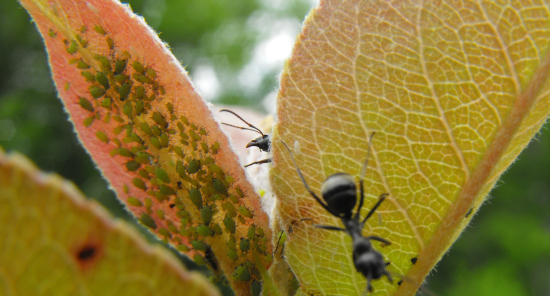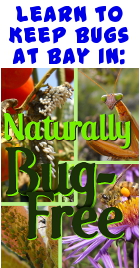
Bad Bug Profile: Aphids

I have to admit that I have a soft spot in my heart for aphids.
Sure, they suck the life out of my vegetables, but did you know that
ants farm aphids just like we farm chickens?
| Species: Many species in the
aphid family (Aphididae) Plants Affected: many types of fruits and vegetables and ornamental plants Natural Enemies: Lady bugs, lacewings, syrphid flies, parasitic wasps. (It's far better to encourage natural populations of these predators than to introduce them.) Organic Control: Hosing with water; insecticidal soap (but may harm natural predators) |
An aphid feeds by sticking
its mouthparts into the phloem ("vein") of a
plant. The sap in the plant's phloem is under pressure, so the
liquid rushes into the aphid's body, passing so quickly through its gut
that a large amount of excess sap passes straight through the insect
and out the other end. This liquid, known as honeydew, is high in
carbohydrates. Enter the ants. Ants consume the second-hand sap, but they also take care of the aphids to make sure their meal tickets stay alive. They'll chase away predators and move aphids to new plants. In my garden, aphids don't tend to be a huge problem. In the spring, I start to see their populations exploding, then ladybug larvae show up and eat the aphids. The ecosystem tends to equalize at low levels of both aphids and ladybugs. If I'm concerned about an aphid infestation, I usually just squish them with my fingers or spray them with a hose. |
 Read other posts about Organic Insect Control: Read other posts about Organic Insect Control: |
Want more in-depth information? Browse through our books.
Or explore more posts by date or by subject.
About us: Anna Hess and Mark Hamilton spent over a decade living self-sufficiently in the mountains of Virginia before moving north to start over from scratch in the foothills of Ohio. They've experimented with permaculture, no-till gardening, trailersteading, home-based microbusinesses and much more, writing about their adventures in both blogs and books.
Want to be notified when new comments are posted on this page? Click on the RSS button after you add a comment to subscribe to the comment feed, or simply check the box beside "email replies to me" while writing your comment.
Add a comment
